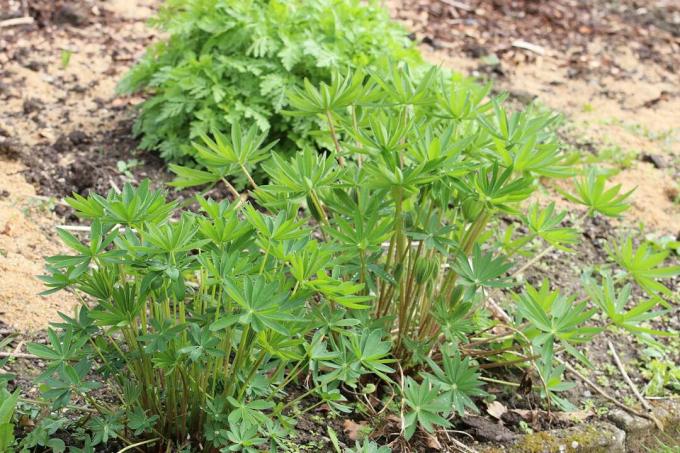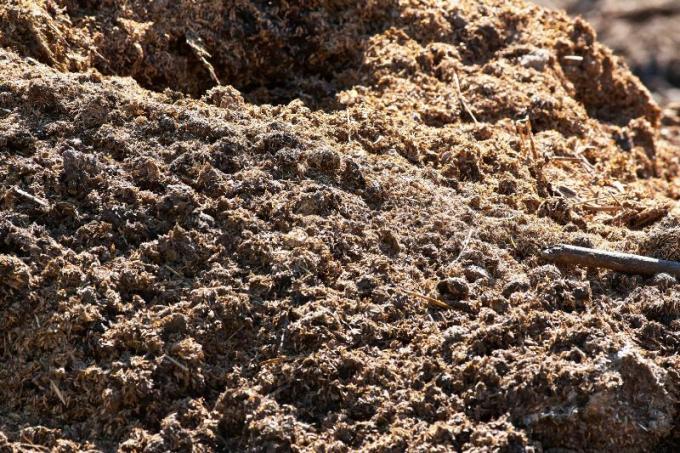
Due to their dense root network and their large leaf mass, lupins are ideal for green manure. They enrich nutrients in the soil, but the incorporation is a bit more complex because the lupins are hardy.
In a nutshell
- Only use lupine varieties that are designated as green manure
- Sowing can be done late in the year
- before sowing, only the area of plants or get rid of weeds
- Cut off the lupins and roughly chop before incorporating
- Plant the area two to three weeks after incorporation
Table of contents
- variety selection
- sowing
- Care
- Incorporate green manure
- frequently asked Questions
variety selection
White, yellow or blue lupins are suitable as green manure. Which variety you choose depends on the properties of the soil.

White Lupine:
- sandy
- low in lime
- permeable
Yellow Lupine:
- sandy
- low in lime

Blue Lupine:
- well drained to heavy soils
- loamy
- calcareous

Mixtures with lupins as green manure often contain different varieties. However, if you have a very calcareous soil, prefer seeds that consist exclusively of the blue lupine, as the other species would only grow poorly.
sowing
The fact that lupins are hardy has both advantages and disadvantages. One advantage is that you can sow green manure late in the year. Sowing is possible until October. The lupins are sown directly into the bed. Green manure is ideal as preparation for heavy feeders next year. The bed preparation is not complex, the area should only be largely cleared.
Sow lupins:
- Roughly loosen the soil
- Scatter the lupins evenly
- Work about 2 cm into the soil
- press earth
In principle, lupins can be applied as green manure all year round in a frost-free period. The optimal germination temperature is 16 – 18 °C. The germination period is one to two weeks on average. If sown until October, the lupins will still form beautiful clumps and will continue to grow roots and leaves during the frost-free period.

Mixtures with lupins as green manure often contain different varieties. However, if you have a very calcareous soil, prefer seeds that consist exclusively of the blue lupine, as the other species would only grow poorly.
Care
The lupins are not difficult to care for. In the first three weeks after sowing, you should always keep the area moist so that the seedlings do not dry out.
Until the lupins have formed small clumps, you should protect the plants from snails in a smaller area. As soon as they are larger, there is no longer a risk that the plants will be destroyed by the snails.
Incorporate green manure
The disadvantage of green manure with lupins is that they do not freeze over the winter. This means that at some point you will have to cut off the plants and then incorporate everything afterwards. Lupins for green manure are annual or biennial. You can wait until the plants have withered, because then they will quickly move in. Then the green manure can be worked in more easily, but then the fertilizing effect is somewhat weaker, since dried parts of the plant no longer bring as many nutrients into the soil.
Instruction for training:
- Cut off the plant below the root collar
- Roughly chop plant parts
- incorporate shredded plants into the soil
Due to the extensive network of roots, it does not make sense to pierce. It is sufficient if you loosen the surface of the soil by working it in. In the case of manual incorporation, it is advisable to cut off the plant below the root collar to prevent it from sprouting. For example, if you use a motor hoe to incorporate the plant parts, you can simply cut off the surface of the plants. The motor hoe usually shreds the rest so well that it is no longer possible for the plants to sprout.

You should wait two to three weeks before replanting the area. During this time, part of the plant material and roots has already decomposed and is available for new cultures.
frequently asked Questions
Lupins enter into a symbiosis with bacteria that accumulate nitrogen in the roots. The nitrogen is taken up by the plants. This makes the nitrogen in the air available as fertilizer in the soil. The root network can reach a length of over a meter, which deeply loosens the soil. In addition, the leaf mass provides additional nutrients when it rots.
No, you don't have to cut back the lupins if they stay in the bed over the winter. If parts of the plant die off over the winter, they remain on the bed and are incorporated into the soil.
Lupins can reach a height of up to one meter. The average space required per plant is half a square meter. As green manure, you can sow the lupines more densely, they will not form as much leaf mass, but root well into the soil.
Except for perennial herbs, which prefer poor soil, you can use lupins as green manure for all plants that do not belong to the same plant family. You should not plant beans or peas directly in the area where you had lupins as green manure.



